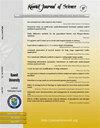变废为利:香蕉皮生物炭颗粒电极在3d -电化学系统中促进甲基紫2B染料的去除
IF 1.1
4区 综合性期刊
Q3 MULTIDISCIPLINARY SCIENCES
引用次数: 0
摘要
水溶性阳离子染料对人类健康和水生生态系统构成重大威胁。然而,传统的吸附剂和去除技术在去除废水中是无效的。为了解决这一具有挑战性的问题,我们合成了香蕉皮生物炭(BPB),并在一个尖端的三维电化学系统中,利用钛(Ti)阳极和石墨(GP)阴极(BPB - Ti/GP),揭示了它作为颗粒电极去除致癌甲基紫2B染料(MV 2B)的作用。通过线性扫描伏安法和循环伏安法研究了BPB的催化特性,发现其具有1.86 V的高析氧电位(OEP)。BPB颗粒电极的高OEP通过降低电化学体系的析氧副反应(OER)来诱导MV 2B染料氧化。在电流密度(j)为5.2 mA/cm2, pH为9.0,Na2SO4用量为0.2 M的最佳操作条件下,在40 min的电解时间内,对10 mg/L MV 2B染料的去除率接近99.50%。与BPB-Ti/GP体系相比,采用GAC、MnO2和Fe3O4等商业颗粒电极的体系性能不显著。计算了BPB-Ti/GP体系的单次能耗和单次电能。此外,羟基自由基(•OH)被确定为主要的活性氧。液相色谱-质谱分析表明,MV 2B通过n -去甲基化降解。这种独特的方法不仅减少了农业浪费,而且还促进了废水处理过程的可持续性,为更绿色的环境解决方案铺平了道路。本文章由计算机程序翻译,如有差异,请以英文原文为准。

Turning waste into value: Banana peel biochar particle electrode boost methyl violet 2B dye removal in 3D-electrochemical system
Water-soluble cationic dyes pose significant risks to human health and aquatic ecosystems. However, conventional adsorbents and removal techniques are ineffective in eliminating them from wastewater. To address this challenging issue, we synthesized banana peel biochar (BPB) and unveiled its role as a particle electrode for the removal of carcinogenic methyl violet 2B dye (MV 2B) in a cutting-edge three-dimensional electrochemical system with the use of titanium (Ti) anode and graphite (GP) cathode (BPB–Ti/GP). Catalytic features of the BPB were explored and its electrochemical characteristics were studied through linear sweep voltammetry and cyclic voltammetry revealed a high oxygen evolution potential (OEP) of 1.86 V. High OEP of BPB particle electrode induced the MV 2B dye oxidation by reducing the oxygen evolution side reaction (OER) of the electrochemical system. At optimum operating conditions of the current density (j) of 5.2 mA/cm2, pH 9.0, and Na2SO4 dose of 0.2 M, nearly 99.50 % of 10 mg/L MV 2B dye removal was attained in 40 min of electrolysis time. Compared to the BPB-Ti/GP system, the system with commercial particle electrodes (GAC, MnO2, and Fe3O4) showed no significant performance. Energy consumption and electrical energy per order of BPB-Ti/GP system was also calculated. Furthermore, hydroxyl radical (•OH) was identified as the dominant reactive oxygen species. Moreover, liquid chromatography-mass spectroscopy analysis showed that MV 2B underwent degradation through N-demethylation. This unique approach does not only reduce agricultural waste but also induce the sustainability of wastewater treatment processes, paving the way for greener environmental solutions.
求助全文
通过发布文献求助,成功后即可免费获取论文全文。
去求助
来源期刊

Kuwait Journal of Science
MULTIDISCIPLINARY SCIENCES-
CiteScore
1.60
自引率
28.60%
发文量
132
期刊介绍:
Kuwait Journal of Science (KJS) is indexed and abstracted by major publishing houses such as Chemical Abstract, Science Citation Index, Current contents, Mathematics Abstract, Micribiological Abstracts etc. KJS publishes peer-review articles in various fields of Science including Mathematics, Computer Science, Physics, Statistics, Biology, Chemistry and Earth & Environmental Sciences. In addition, it also aims to bring the results of scientific research carried out under a variety of intellectual traditions and organizations to the attention of specialized scholarly readership. As such, the publisher expects the submission of original manuscripts which contain analysis and solutions about important theoretical, empirical and normative issues.
 求助内容:
求助内容: 应助结果提醒方式:
应助结果提醒方式:


